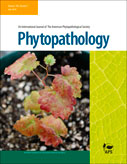View Item
- xmlui.general.dspace_homeCentros e Institutos de InvestigaciónCIAP. Centro de Investigaciones AgropecuariasInstituto de Patología VegetalArtículos científicosxmlui.ArtifactBrowser.ItemViewer.trail
- DSpace Home
- Centros e Institutos de Investigación
- CIAP. Centro de Investigaciones Agropecuarias
- Instituto de Patología Vegetal
- Artículos científicos
- View Item
Characterization of Argentinian Endemic Aspergillus flavus Isolates and Their Potential Use as Biocontrol Agents for Mycotoxins in Maize
Abstract
Maize (Zea mays L.) is a highly valuable crop in Argentina, frequently contaminated with the mycotoxins produced by Aspergillus flavus. Biocontrol products formulated with atoxigenic (nontoxic) strains of this fungal species are well known as an effective method to reduce this contamination. In the present study, 83 A. flavus isolates from two maize regions of Argentina were characterized and evaluated for their ability to produce or lack of producing
[ver mas...]
Maize (Zea mays L.) is a highly valuable crop in Argentina, frequently contaminated with the mycotoxins produced by Aspergillus flavus. Biocontrol products formulated with atoxigenic (nontoxic) strains of this fungal species are well known as an effective method to reduce this contamination. In the present study, 83 A. flavus isolates from two maize regions of Argentina were characterized and evaluated for their ability to produce or lack of producing mycotoxins in order to select atoxigenic strains to be used as potential biocontrol agents (BCA). All of the isolates were tested for aflatoxin and cyclopiazonic acid (CPA) production in maize kernels and a liquid culture medium. Genetic diversity of the nonaflatoxigenic isolates was evaluated by analysis of vegetative compatibility groups (VCG) and confirmation of deletions in the aflatoxin biosynthesis cluster. Eight atoxigenic isolates were compared for their ability to reduce aflatoxin and CPA contamination in maize kernels in coinoculation tests. The A. flavus population was composed of 32% aflatoxin and CPA producers and 52% CPA producers, and 16% was determined as atoxigenic. All of the aflatoxin producer isolates also produced CPA. Aflatoxin and CPA production was significantly higher in maize kernels than in liquid medium. The 57 nonaflatoxigenic strains formed six VCG, with AM1 and AM5 being the dominant groups, with a frequency of 58 and 35%, respectively. In coinoculation experiments, all of the atoxigenic strains reduced aflatoxin from 54 to 83% and CPA from 60 to 97%. Members of group AM1 showed a greater aflatoxin reduction than members of AM5 (72 versus 66%) but no differences were detected in CPA production. Here, we described for the first time atoxigenic isolates of A. flavus that show promise to be used as BCA in maize crops in Argentina. This innovating biological control approach should be considered, developed further, and used by the maize industry to preserve the quality properties and food safety of maize kernels in Argentina.
[Cerrar]

Author
Camiletti, Boris Xavier;
Moral, Juan;
Asensio, Claudia Mariana;
Torrico Ramallo, Ada Karina;
Lucini, Enrique Iván;
Gimenez, Maria De La Paz;
Michailides, Themis J.;
Fuente
Phytopathology 108 (7) : 818-828 (2018)
Date
2018-05-07
Editorial
American Phytopathological Society
ISSN
0031-949X
Formato
pdf
Tipo de documento
artículo
Palabras Claves
Derechos de acceso
Abierto
 Excepto donde se diga explicitamente, este item se publica bajo la siguiente descripción: Creative Commons Attribution-NonCommercial-ShareAlike 2.5 Unported (CC BY-NC-SA 2.5)
Excepto donde se diga explicitamente, este item se publica bajo la siguiente descripción: Creative Commons Attribution-NonCommercial-ShareAlike 2.5 Unported (CC BY-NC-SA 2.5)


